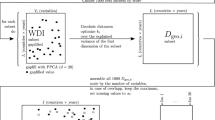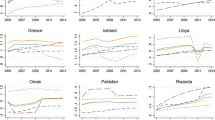Abstract
In this study, we used the weighted principal component method on the human development indicators to measure and analyzethe progress of human development in the world. The main principal component was employed to quantify the temporal changes of the human development of several selected countries by the proposed Z-test. The trends of the human development in the period of market transition in two large countries, China and Russia, were discussed in terms of the impact of public health as well as economic development. The association of the main principal component obtained from our study and the human development index reported by the United Nations Development Programme was estimated by the Spearman’s rank correlation coefficient.
Similar content being viewed by others
References
Anderson, T. W.: 1984, An Introduction to Multivariate Statistical Analysis (Wiley, New York).
Carlucci, F. and S. Pisani: 1995, ‘A multiattribute measure of human development’, Social Indicators Research 36, pp. 145–176.
Custance, J. and H. Hillier: 1998, ‘Statistical issues in developing indicators of sustainable development’, Journal of Royal Statistical Society, Ser. A 161, pp. 281–290.
Dasgupta, P. and M. Weale: 1992, ‘On measuring the quality of life’, World Development 20, pp. 119–131.
Gerber T. R. and M. Hout: 1998, ‘More shock than therapy: Market transition, employment, and income in Russia, 1991–1995’, American Journal of Sociology 104, pp. 1–50.
Kelley, A. C.: 1991, ‘The human development index: Handle with care’, Population and Development Review 17, pp. 315–324.
Levett, R.: 1998, ‘Sustainability indicators – integrating quality of life and environmental protection’, Journal of Royal Statistical Society, Ser. A 161, pp. 291–302.
Lind, N. C.: 1992, ‘Some thoughts on the human development index’, Social Indicators Research 27, pp. 89–101.
Lind, N. C.: 1993, ‘A compound index of national development’, Social Indicators Research 28, pp. 267–284.
McGillivray, M.: 1991, ‘The human development index: Yet another redundant composite development indicator?’, World Development 19, pp. 1461–1468.
Noorbakhsh, F.: 1998a, ‘A modified human development index’, World Development 26, pp. 517–528.
Noorbakhsh, F.: 1998b, ‘The human development indices: Are they redundant?’, Journal of International Development, to appear.
Notzon, F. C., Y. M. Komarov, S. P. Ermakov, C. T. Sempos, J. S. Marks and E. V. Sempos: 1998, ‘Causes of declining life expectancy in Russia’, Journal of American Medical Association 279, pp. 793–800.
Rao, C. R.: 1965, ‘The use and interpretation of principal component analysis in applied research’, Sankhya A 26, pp. 329–358.
Ravallion, M.: 1997, ‘Good and bad growth: The human development reports’, World Development 25, pp. 631–638.
Sagar, A. D. and A. Najam: 1998, ‘The human development index: A critical review’, Ecological Economics 25, pp. 249–264.
Sen, A.: 1998, ‘Human development and financial conservatism’, World Development 26, pp. 733–742.
Srinivasan, T. N.: 1994, ‘Human development: A new paradigm or reinvention of the wheel?’, American Economic Review, Papers and Proceedings 84, pp. 238–243.
United Nations (UN), Department of Economic and Social Affairs: 1998, ‘Demographic Yearbook, 1996’ (United Nations, New York).
United Nations Development Programme (UNDP): 1990–1998, Human Development Report (Oxford University Press, New York).
Author information
Authors and Affiliations
Rights and permissions
About this article
Cite this article
Lai, D. Temporal Analysis of Human Development Indicators: Principal Component Approach. Social Indicators Research 51, 331–366 (2000). https://doi.org/10.1023/A:1007065804509
Issue Date:
DOI: https://doi.org/10.1023/A:1007065804509




